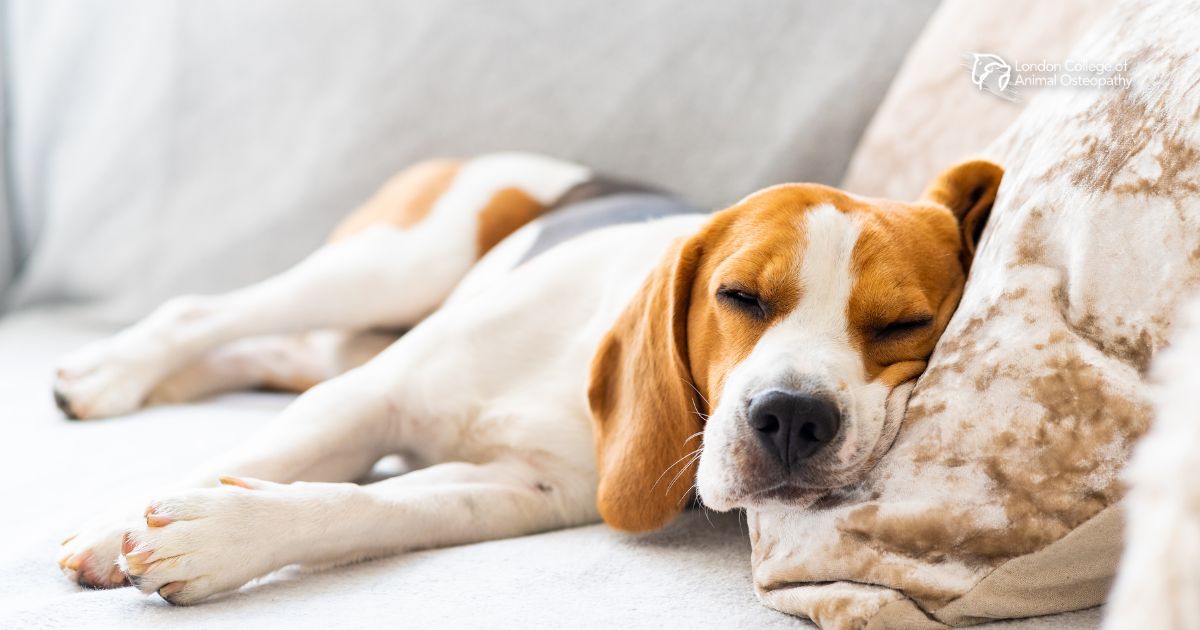From the high-speed zoomies around the garden to the blissful snoring under a blanket, our pets move through a wide range of daily activity. But just like in humans, quality sleep is essential for their health, impacting everything from recovery and immunity to mood and behaviour. Interestingly, manual therapy techniques such as massage and soft-tissue mobilisation are increasingly being used not only for physical rehabilitation, but also to improve rest, relaxation, and sleep quality in animals.
So, how exactly does hands-on therapy help turn the dial from overdrive to deep rest?
The Physiology of Relaxation
Sleep is regulated by a complex balance between the sympathetic nervous system (responsible for alertness and activity) and the parasympathetic nervous system (which promotes rest, digestion, and repair). Manual therapy has been shown to activate the parasympathetic response, often referred to as the “rest and digest” state. This shift can be measured through reduced heart rate, lower blood pressure, and decreased circulating cortisol (a stress hormone).
In a 2021 peer-reviewed review of physiological effects in animals, manual therapy was shown to influence autonomic tone, increase local circulation, and stimulate neurochemical changes that encourage relaxation. These physiological responses are key precursors to healthy, restorative sleep.
Hormones, Touch, and Sleep
Massage therapy doesn’t just relax the body; it also interacts with the endocrine system. Research shows that massage can reduce cortisol levels while increasing serotonin and dopamine, neurotransmitters linked to mood stability and sleep regulation. In animals, especially those with anxiety or sensory processing issues, this shift in neurochemistry may make the difference between restlessness and restful sleep.
Gentle massage techniques can also reduce muscular tension and lower breathing rates, two physical signs that the body is transitioning into a rest-ready state. This can be particularly helpful for post-operative patients, senior animals, or pets recovering from chronic pain, where sleep is often disrupted by discomfort.
From Clinical Rehab to Bedtime Routine
In canine and feline rehabilitation, many therapists have observed that animals receiving manual therapy sessions, especially in the afternoon or evening, tend to settle more easily, sleep more deeply, and demonstrate fewer nocturnal behaviours associated with pain or tension. While formal research on sleep outcomes in pets is still limited, these observations align with the physiological effects documented in both human and veterinary literature.
Manual therapy may also help reduce anxiety, which is a common barrier to restful sleep. In companion animals, massage therapy has been associated with better adaptation to handling, lowered reactivity, and even improved sleep-wake cycles, particularly in animals housed in shelter or clinic settings.
Cautions and Considerations
Not all hands-on work is calming. Overly stimulating or poorly timed manual therapy, especially techniques involving high-pressure or rapid mobilisation, can increase arousal and interfere with the goal of inducing rest. For sleep-supporting effects, the focus should be on gentle, rhythmic, low-intensity techniques such as effleurage, myofascial release, or craniosacral-style stillness techniques.
It’s also important to consider the animal’s context. Manual therapy should never replace medical diagnosis or treatment for chronic insomnia or restlessness. But when integrated thoughtfully and safely, it can serve as a valuable adjunct to behaviour management, recovery protocols, or wellness care.
Conclusion
Sleep is one of the most underrated aspects of animal health, and manual therapy, when applied with skill and understanding, can play a surprising and meaningful role in supporting it. Whether it's easing residual tension, shifting the nervous system toward rest, or simply creating space for quiet connection, these gentle techniques help pets move from zoom to zzz with comfort and calm.
Resources for Further Reading
Corti et al. (2014). Massage Therapy for Dogs and Cats. PubMed.
https://pubmed.ncbi.nlm.nih.gov/25454377/
Marcellin-Little et al. (2021). Physiological Responses Induced by Manual Therapy in Animals. PMC.
https://www.ncbi.nlm.nih.gov/pmc/articles/PMC7227122/
Integrative HealthCare Institute. Companion Animals Benefit from Massage Therapy.
https://www.integrativehealthcare.org/mt/benefits-of-animal-massage/
PetMD. (2025). Dog Massage: Everything to Know About Canine Massages. https://www.petmd.com/dog/general-health/dog-massage-everything-to-know-about-canine-massages



.png)
.png)